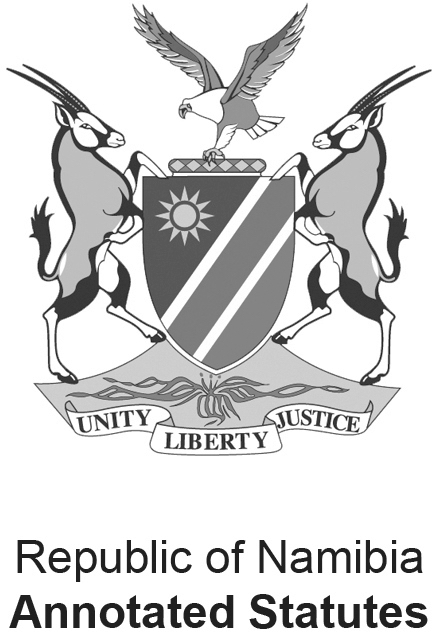
Labour Act, 2007
Labour General Regulations, 2008
Government Notice 261 of 2008
- Published in Government Gazette 4151 on 31 October 2008
- Commenced on 1 November 2008
- [This is the version of this document at 15 November 2017.]
- [Note: The version of this legislation as at 15 November 2017 was revised and consolidated by the Legal Assistance Centre and the Government of the Republic of Namibia. All subsequent amendments have been researched and applied by Laws.Africa for NamibLII.]
1. Definitions
In these regulations, any word or expression to which a meaning has been given in the Act bears that meaning, and unless the context otherwise indicates, “the Act” means the Labour Act, 2007 (Act No. 11 of 2007).2. Portion of basic wage that may be paid in-kind and calculation of the value of in-kind payments
3. Written statement of particulars of monetary remuneration
The written statement of particulars referred to in section 11(3) that must accompany payment of monetary remuneration to an employee must contain the matters set out Annexure 1.4. Exemption from a wage order
5. Compassionate leave
6. Election of health and safety representatives
7. Change in constitution of registered trade union or registered employers’ organization
8. Registration of trade union or employers’ association
9. Register maintained by registered trade unions or registered employers’ organization
The register to be maintained by registered trade unions and registered employer organisations in terms of section 60(a) of the Act must be on maintained on Form LC 8 set out in Annexure 2.10. Annual return of registered trade union or employers’ organization
The annual return to be submitted to the Labour Commissioner in terms of section 60(e) of the Act must be on Form LC 9, and must be accompanied by a statement of income and expenditure for that year, a balance sheet showing its financial position at the end of the year, and its annual audit report prepared by a registered public accountant and auditor or an auditor approved by the Labour Commissioner.11. Request for recognition of registered trade union as exclusive bargaining agent
12. Notification to registered trade union to acquire majority representation
Notice which must be given in terms of section 64(11) of the Act by an employer to a trade union recognised as an exclusive barganing agent, when the employer considers that the trade union no longer represents the majority of the employees in the bargaining unit, must be given on Form LC 13 set out in Annexure 2.[The word “bargaining” is misspelt in the Government Gazette, as reproduced above.]13. Election of workplace union representatives
14. Request to extend collective agreement to non-parties to the agreement
15. Application for exemption from extension of collective agreement
16. Notice of commencement of strike or lockout
17. Appointment of conciliators and arbitrators
Where the Minister appoints-18. Referral of dispute to conciliation
19. Application to reverse decision of a conciliator
An application to the Labour Commissioner in terms of section 83(3)(a) of the Act to reverse a decision of a conciliator must be made on Form LC 26 set out in Annexure 2.20. Referral of dispute to arbitration
21. Request for representation at conciliation or arbitration
A request for representation at conciliation or arbitration proceedings in terms of section 82(13) or 86(13) of the Act, respectively, must be made on Form LC 29 set out in Annexure 2.22. Application to enforce arbitration award
An application to a labour inspector to enforce an arbitration award in terms of section 90 of the Act must be made on Form LC 30 set out in Annexure 2.23. Order to appear before a labour inspector
The order of a labour inspector in terms of section 125(2)(b) of the Act requiring a party to appear at a specified time, date and place for questioning must be on Form LS 31 set out in Annexure 2.24. Compliance order
25. Records and returns
26. Application for exemption or variation
27. Proof of service of documents
Proof of service of documents in respect of conciliation or arbitration proceedings in terms of section 82(8) or 86(3) or any other provision of the Act, must be made in the form of the affidavit of service on Form LG 36 set out in Annexure 2.28. Commencement of regulations
These regulations come into operation on 1 November 2008.History of this document
15 November 2017 this version
Consolidation
01 November 2008
Commenced